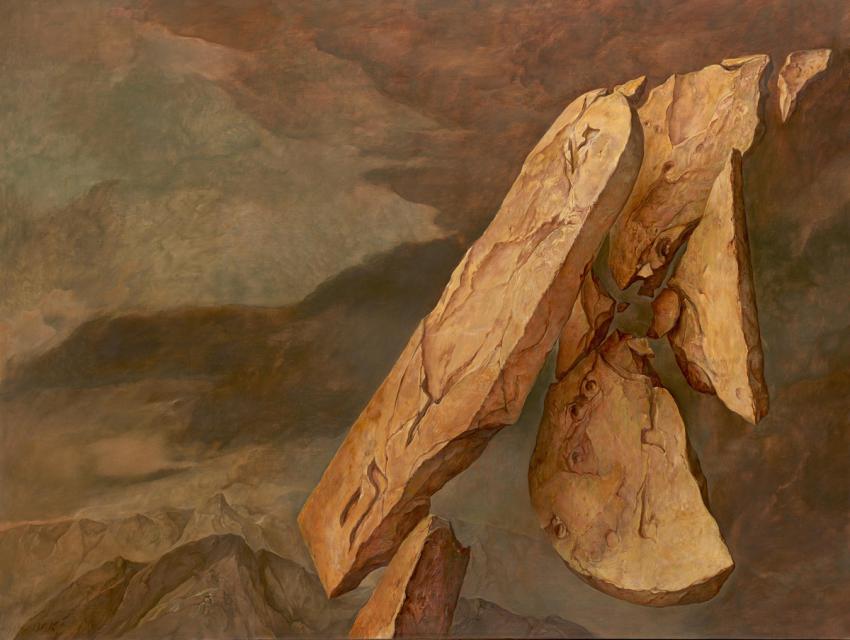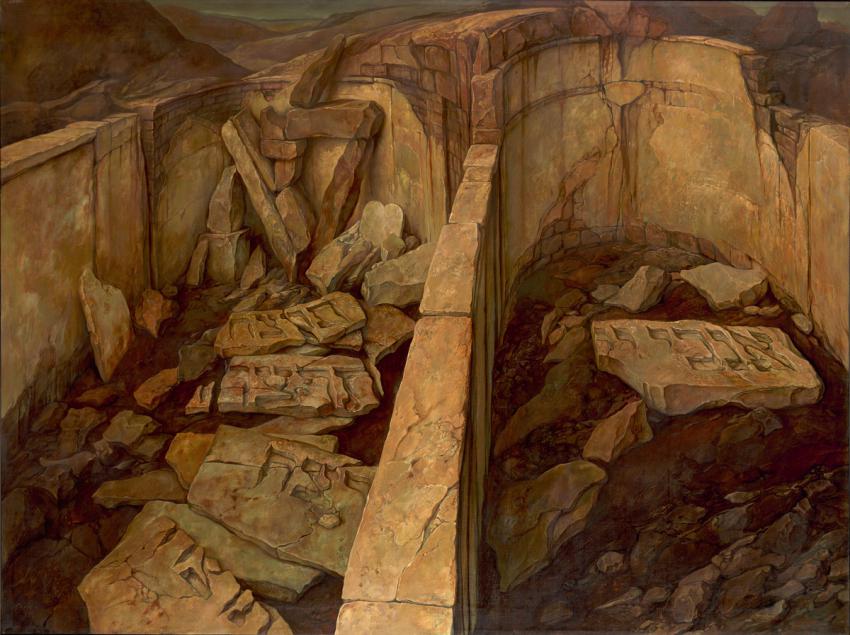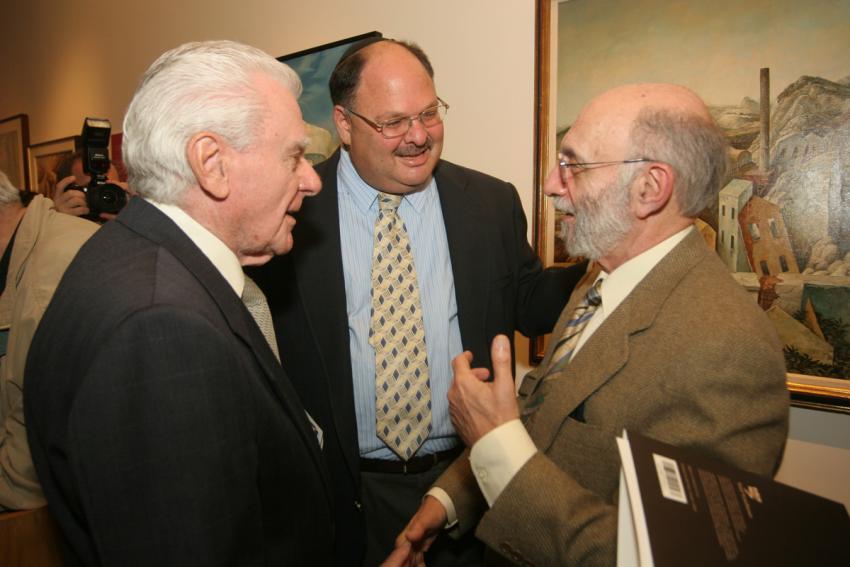
Diptych
Oil on canvas
Collection of the Yad Vashem Art Museum, Jerusalem
Gift of the artist


Diptych
Oil on canvas
Collection of the Yad Vashem Art Museum, Jerusalem
Gift of the artist



Sunday to Thursday: 09:00-17:00
Fridays and Holiday eves: 09:00-14:00
Yad Vashem is closed on Saturdays and all Jewish Holidays.
Entrance to the Holocaust History Museum is not permitted for children under the age of 10. Babies in strollers or carriers will not be permitted to enter.

Diptych
Oil on canvas
Collection of the Yad Vashem Art Museum, Jerusalem
Gift of the artist


Diptych
Oil on canvas
Collection of the Yad Vashem Art Museum, Jerusalem
Gift of the artist



On 8 December 2006, an exhibition entitled “An Arduous Road: Samuel Bak – 60 Years of Creativity” opened at Yad Vashem’s Exhibitions Pavilion, in the presence of Ambassador of Lithuania H.E. Mrs. Asta Skaisgiryte Liauskiene, celebrated author Amos Oz, renowned artist Samuel Bak, Chairman of the Yad Vashem Council Joseph (Tommy) Lapid, Chairman of the Yad Vashem Directorate Avner Shalev and Senior Art Curator of Yad Vashem’s Museums Division Yehudit Shendar.
“The interconnected journey of the artist and his burden are not unique to the life of Samuel Bak,” explains Yehudit Shendar. “Bak’s work is a paradigm for survivors’ narratives—the men and women who undertook life’s journey after coming face to face with death and its horrors. They carry within them a load that is both personal and collective—the story of the Holocaust of European Jewry. On reaching Israel in 1948, Bak, like his surviving brethren, first donned the mantle of silence, seeking assimilation into Israeli life. This veneer of silence was gradually shed in a journey that encompasses countries and continents; until he reached the moment he could no longer carry the weight inside him. At that instant, another road began, a road into the depths of his identity; a road that culminated with a head-on encounter with the realization that the burden is an integral part of himself and, therefore inevitably, the crux of his work.”
Samuel Bak was born in Vilna, Lithuania in 1933, and began to draw at an early age. His drawings were first displayed in the Vilna ghetto in 1943. Bak recalls:
“The artists of Vilna who had survived the numerous executions were about to exhibit their works, and a respectable group of my sketches took up an entire wall. My parents and I, holding hands, crossed the square, which looked like a malodorous garbage heap. The ground was strewn with hundreds of refugees driven out of the smaller ghettos near our city. One could hardly distinguish between them and their ragged possessions. Some sat on their suitcases, others were standing, and many were lying on the ground, as if their souls had fled. This was my very first exhibition, but these creatures, so sunken in their misery, did not care about that one bit. In two more days, they would be shot to death in the forest of Ponary...
“We went through the door, but the putrid smell oppressing the courtyard still haunts me. The memory of that odor has haunted me and caught up with me at most of my exhibitions. Art, life, suffering, and death—the artist’s soul. Looking back, I learned many things from that moment. But at the time, I just seized my father’s hand once more, perturbed and heartsick at the fate of the crowd outside. They, it seemed, would never see my drawings….
“But perhaps now they can. And my knowledge that this might be possible is the only tikkun (correction of the world) I have to offer—to them and the millions of dead Jews in whose memory this holy place [Yad Vashem] was built.”
Bak’s grandparents were murdered at Ponary, and his father was killed just a few days before the Russians liberated Vilna. After the war’s end, he arrived at the Landsberg DP camp in Germany. Bak immigrated to Israel in 1948, and attended the Bezalel Academy of Art, refining his skills under such celebrated artists as Steinhardt, Ascheim and Ardon. In 1956, he continued his studies at l’Ecole des Beaux Arts in Paris. Since then he has lived and worked in Rome, Israel, New York, Paris and Lausanne, before finally settling in Weston, Massachusetts.
“There is no artist that portrays collective memory better than Samuel Bak,” said Amos Oz at the opening of the exhibition. “I not only see his works, I also feel, smell and hear them… for shed upon them is a light not of this world, a light unlike both natural and artificial light: a light in of itself – the light that Samuel Bak created to illuminate his world of nightmares.”
In advance of the exhibition, Bak reflected upon his life:
“To tell the truth, I am still stunned by the fact that my long and exhausting journey pursuing my art has ended at a finishing line, which could not have any greater meaning for me, here in this exhibition at Yad Vashem… I don’t know if there is any place on earth that is more appropriate for exhibiting my work. These paintings have been my home during the different chapters of my life and my experiences. If this is not a homecoming, then I don’t know what is.”
Curator of the Exhibition: Yehudit Shendar; Assistant Curator, Keren Katsir-Stiebel
The exhibition was made possible with the generous support of the Pucker Gallery (USA), the Ann Bronfman Foundation (USA), the Pritzker Pucker Family Foundation (USA), Dr. Miriam and Sheldon G. Adelson (USA), Dr. and Mrs. Gary Stein of the Millstein Charitable Foundation (USA) Mr. Edgar Bronfman (USA), the American Society for Yad Vashem, the Solomon Family Charitable Trust (UK), and Dr. André and Carolyne Bollag (Switzerland).
First published in Yad Vashem Jerusalem magazine, #44, January 2007

Thank you for registering to receive information from Yad Vashem.
You will receive periodic updates regarding recent events, publications and new initiatives.

"The work of Yad Vashem is critical and necessary to remind the world of the consequences of hate"
Paul Daly
#GivingTuesday
Donate to Educate Against Hate


Worldwide antisemitism is on the rise.
At Yad Vashem, we strive to make the world a better place by combating antisemitism through teacher training, international lectures and workshops and online courses.
We need you to partner with us in this vital mission to #EducateAgainstHate
The good news:
The Yad Vashem website had recently undergone a major upgrade!
The less good news:
The page you are looking for has apparently been moved.
We are therefore redirecting you to what we hope will be a useful landing page.
For any questions/clarifications/problems, please contact: webmaster@yadvashem.org.il
Press the X button to continue



